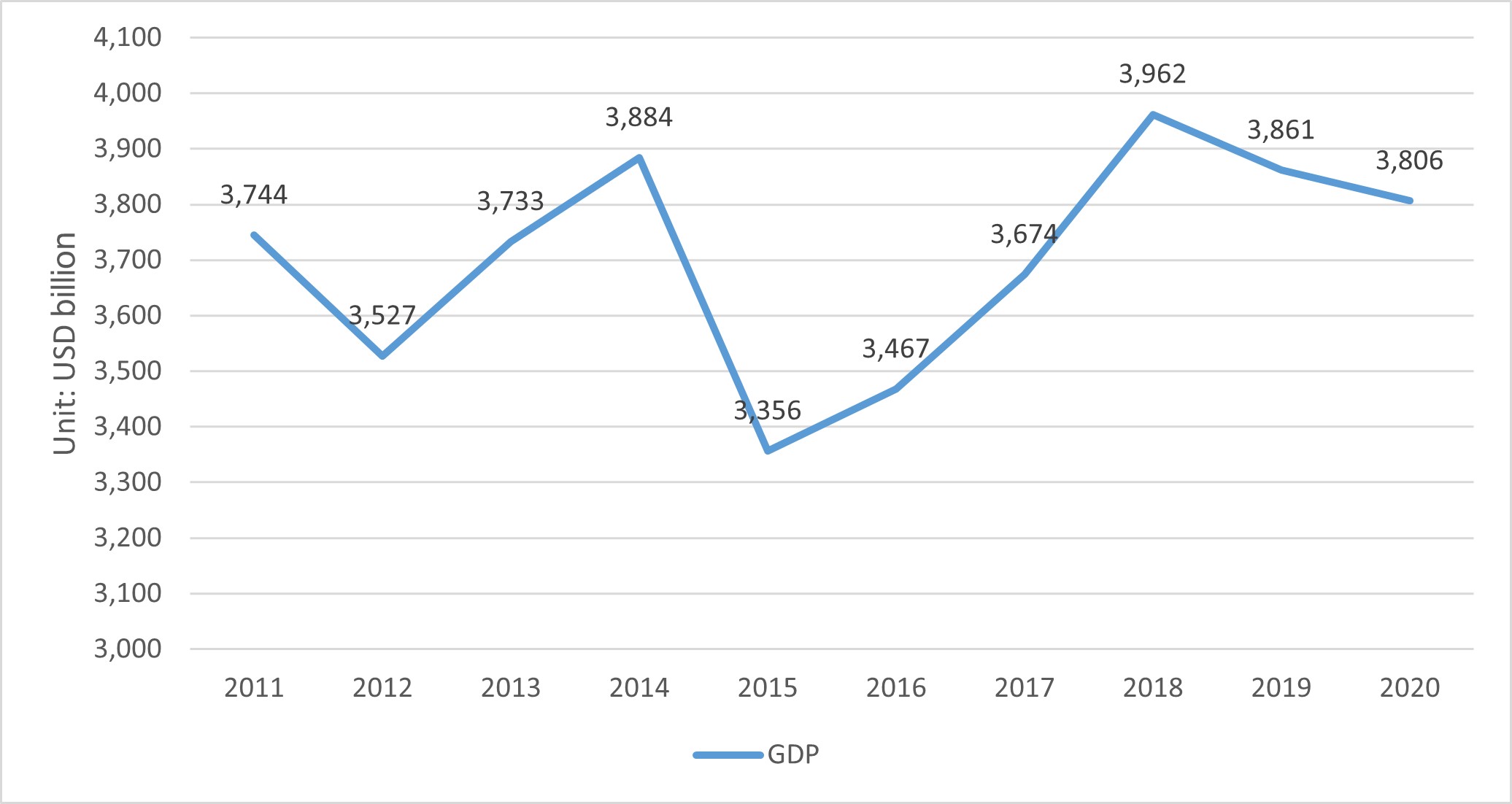What are notable characteristics of the German market for Vietnamese exporters?
Question: What are notable characteristics of the German market for Vietnamese exporters?
Answer:
Market size
Germany is the largest economy in Europe and the 4th largest in the world. According to the World Bank, in 2020, Germany's GDP reached USD 3.806 billion (only after the US with GDP of USD 20,937 billion, China with USD 14,723 billion, Japan with USD 5.065 billion). GDP also represents the purchasing power of an economy, and so it's not surprising that Germany is one of the most attractive markets for any exporters.
Figure: Germany’s GDP in the period of 2011-2020

Source: The World Bank, 2021
Over the past decade, Germany's GDP fluctuated unevenly and increased slightly from USD 3.744 billion in 2011 to USD 3.806 billion in 2020. In the past two years, the GDP of this economy decreased due to many reasons, including the impact of trade tensions between major economies (EU - US, US - China...), the influence from the UK's departure from the EU, and especially the outbreak of the COVID-19 pandemic since 2020. In the period of 2011-2020, the average annual growth rate of Germany's GDP was 1.39%, higher than that of the EU's GDP in the same period (0.72%).
Germany's economy is quite stable and has major macroeconomic indicators such as inflation rate, unemployment rate remain at low levels. During the period of 2011-2020, the average inflation rate of Germany was 1.64% and the average unemployment rate was 4.47%.
Germany is one of the developed countries with a relatively large population - about 83.2 million people – ranking 19th in the world and 2nd in Europe in 2020 (World Bank). Germany is also a high-income country in the world with GDP per capita reaching USD 45,724/year in 2020, ranking 16th in the world (Statisticstimes.com). As a result, German consumers have a high level of affordability for consumer goods.
Import and Export
Germany is a country located in Central Europe sharing borders with 9 countries, stretching from the Alps, across the North European Plain to the North Sea and the Baltic Sea, with an area of 349,380 km2 (ranking 7th in Europe). With such a favorable geographical position, Germany's trade is well developed, accounting for 81.1% of the country's GDP (World Bank, 2021).
In Germany, people speak many different languages, besides their mother tongue, up to 56% of the German population uses English, in addition to French, Russian, Turkish, etc. This has also created favorable conditions for Germany in international trade.
For many years, Germany has maintained its position as the worlds’ 3rd largest exporter and importer of goods (after the US and China). According to ITC Trademap, in 2020, Germany's total import and export turnover reached USD 2,550 billion (accounting for about 67% of Germany's GDP), of which exports reached USD 1.378 billion and imports reached USD 1.172 billion.
Germany has a leading manufacturing industry of the world, and although Germany can self-supply a part, it still has a high demand for imports of manufacturing products such as machinery and equipment, raw materials, fuel... besides the demand for importing consumer goods. Below is a summary of the main imported products of Germany in 2020.
Table: Main imported products of Germany in 2020
|
No |
Main import products of Germany |
Import turnover in 2020 (USD billion) |
Proportion in import turnover |
|
1 |
Chapter 84: Machinery, mechanical appliances, nuclear reactors, boilers; parts thereof |
149.87 |
12.79% |
|
2 |
Chapter 85: Electrical machinery and equipment and parts thereof; sound recorders and reproducers, television image and sound recorders and reproducers, and parts and accessories of such articles |
149.32 |
12.74% |
|
3 |
Chapter 87: Vehicles other than railway or tramway rolling stock, and parts and accessories thereof |
123.18 |
10.51% |
|
4 |
Chapter 27: Mineral fuels, mineral oils and products of their distillation; bituminous substances; mineral waxes |
77.80 |
6.64% |
|
5 |
Chapter 30: Pharmaceutical products |
65.80 |
5.62% |
|
6 |
Chapter 90: Optical, photographic, cinematographic, measuring, checking, precision, medical or surgical instruments and apparatus; parts and accessories thereof |
42.73 |
3.65% |
|
7 |
Chapter 39: Plastics and articles thereof |
41.96 |
3.58% |
|
8 |
Chapter 29: Organic chemicals |
37.81 |
3.23% |
|
9 |
Chapter 71: Natural or cultured pearls, precious or semi-precious stones, precious metals, metals clad with precious metal, and articles thereof; imitation jewellery; coin |
29.23 |
2.50% |
|
10 |
Chapter 73: Articles of iron or steel |
21.94 |
1.87% |
Source: ITC Trademap, 2021
For agricultural products, although not in the top 10 of Germany’s most imported products, their import value of Germany is still significant. In 2020, Germany is the EU country that imports the most fresh and processed fruits and vegetables (USD 23.1 billion), tea - coffee - spices (USD 4 billion), processed seafood (USD 1.65 billion), honey (USD 274 million USD), etc. (Trademap ITC, 2021).
Source: The Center for WTO and International Trade
- Where can businesses find support on the EVFTA and German and Vietnamese markets?
- Where can information and data about the German and Vietnamese markets be found?
- How to take advantage of the EVFTA to effectively import goods from Germany?
- Opportunities from the EVFTA for importing goods from Germany into Vietnam?
- What are the advantages and disadvantages of German goods in Vietnam?




